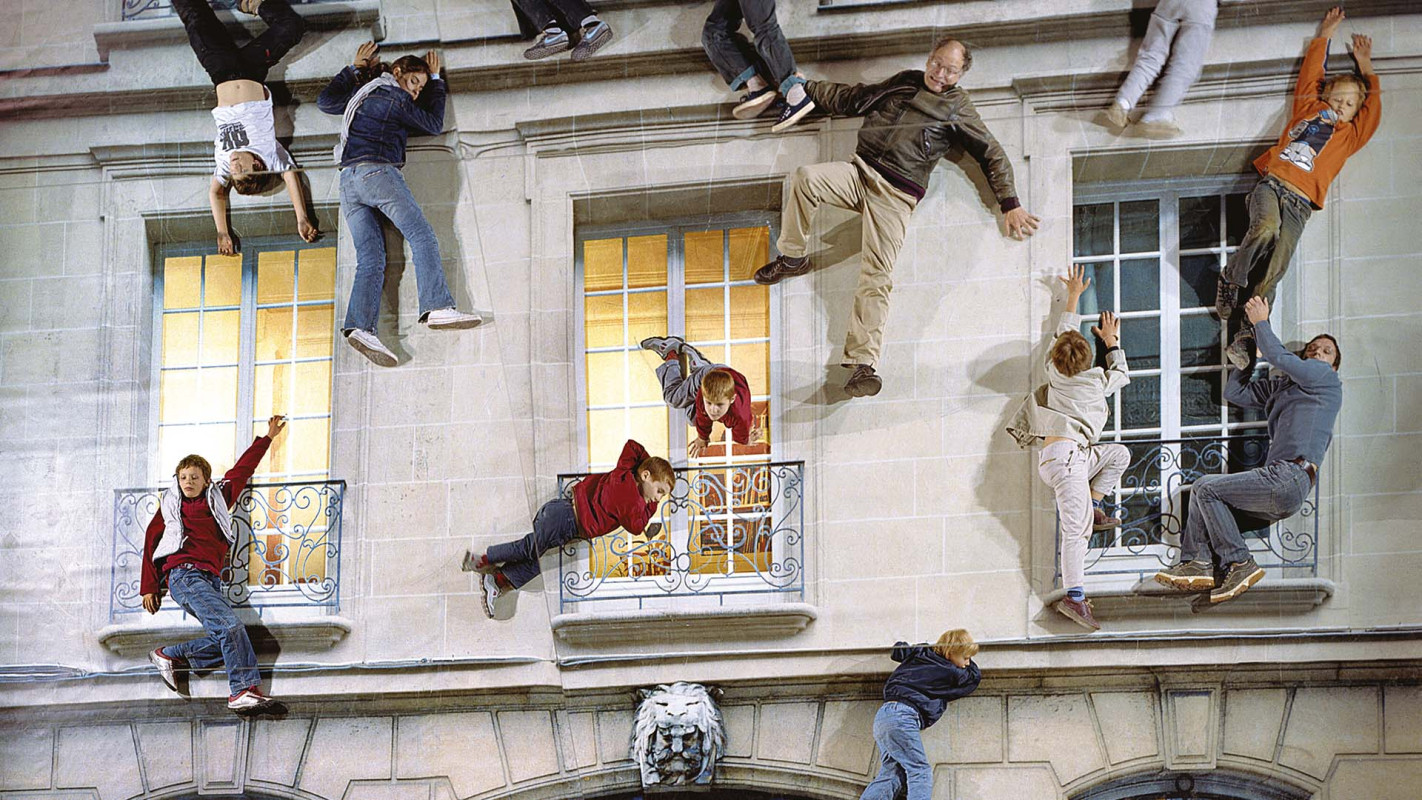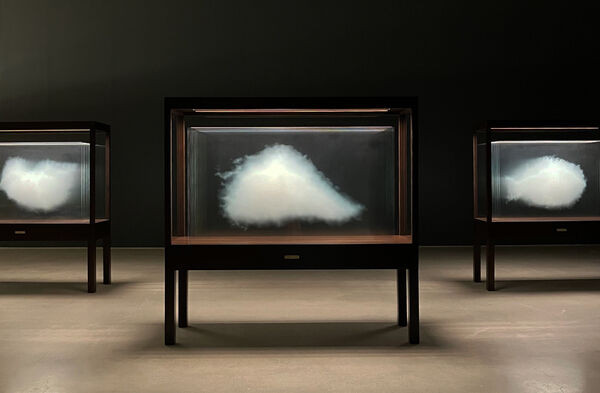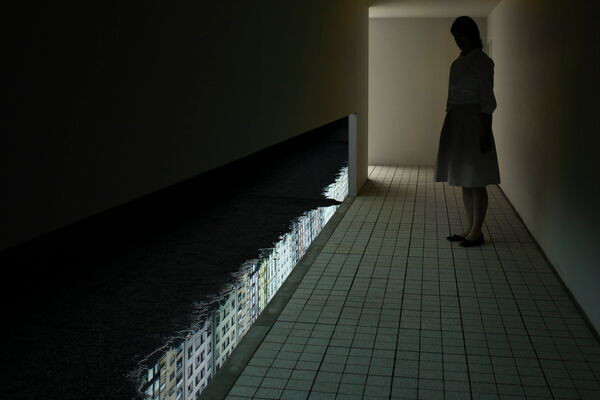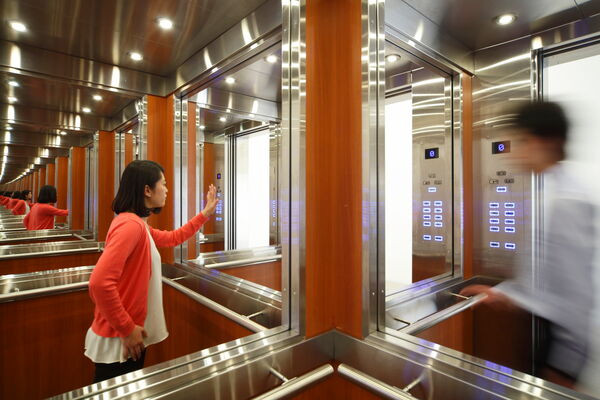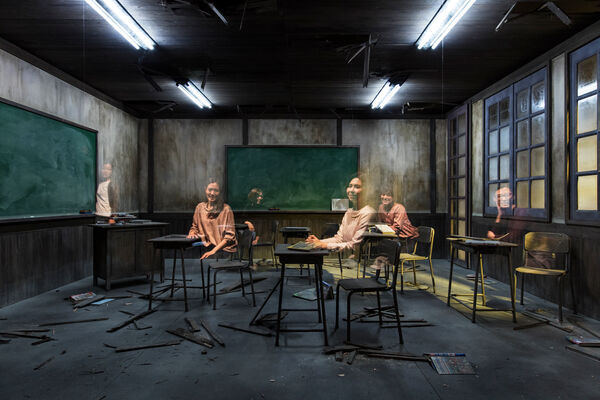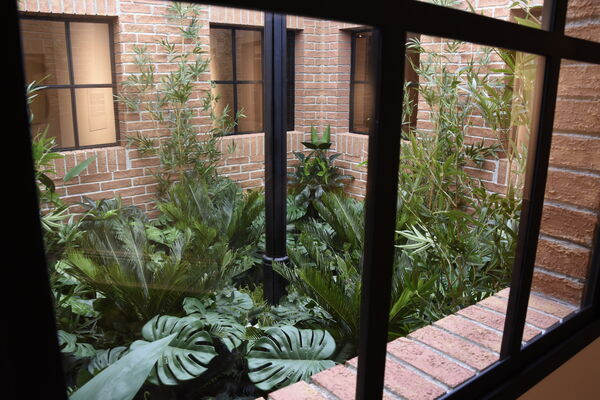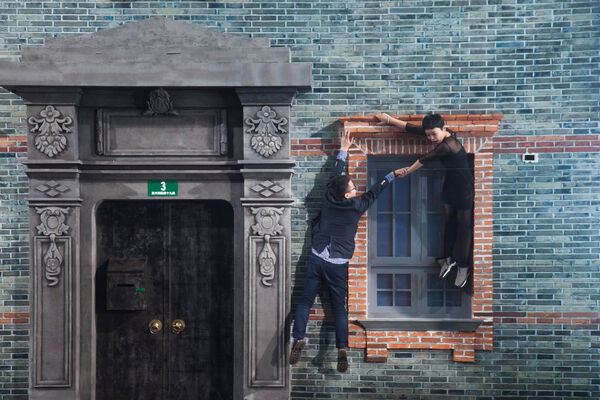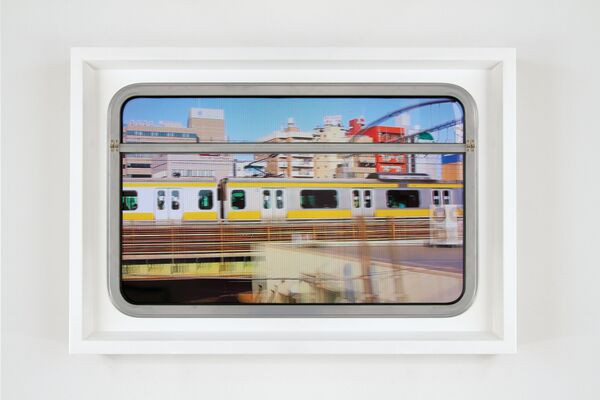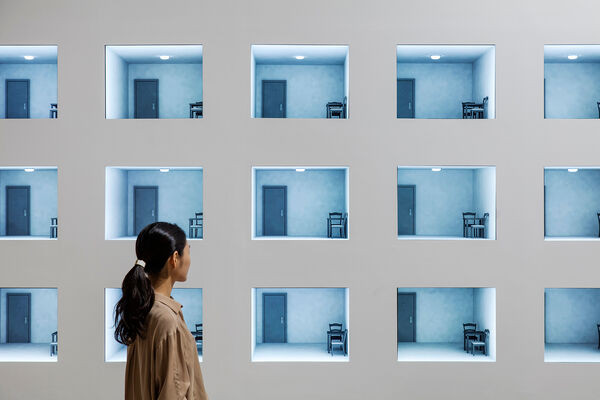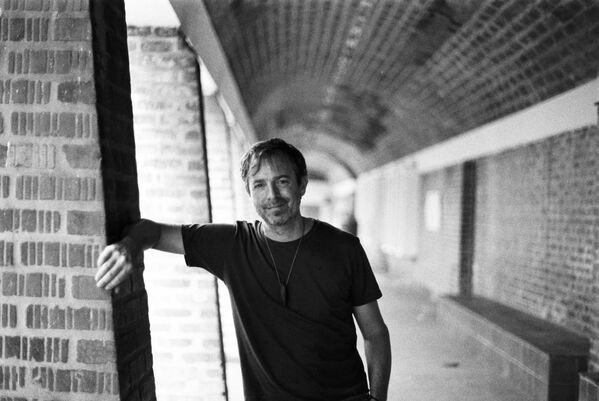Leandro Erlich
How close can art get to everyday reality? Can it change it?
Argentinian artist Leandro Erlich (b. 1973, Buenos Aires) has transformed Amos Rex into a world where the familiar structure of reality is subtly, and sometimes playfully, called into question. As viewers, we may find ourselves doubting our own eyes, while also being invited to surrender to wonder and play.
The exhibition presents ten key artworks from Erlich’s career. These installations resemble stage-set-like transformations of space, continuing the artist’s long-standing exploration of perception and reality. They place us in everyday environments – an elevator, a classroom, a train carriage – that start to feel unfamiliar when viewed within the museum context.
As we move through the exhibition, the atmosphere shifts from dim to bright, from quiet contemplation to an irresistible urge to engage. The exhibition opens with the dreamlike series The Cloud, a gathering of clouds halted mid-motion and captured in glass cases. A stillness that is impossible, but perfectly at home in Erlich’s world.
From there, we enter Sidewalk, where an ordinary streetscape is flipped, challenging us to consider where the line between reality and its reflection lies. Next, Lost Garden, reveals a hidden garden – a fragment of a memory, lost between places and moments.
As we move forward, the familiar grows increasingly surreal. Elevator Maze transforms the everyday elevator into a disorienting labyrinth that leads nowhere. Escaping the maze, we step into a dimly lit room that at first seems empty. A moment later, it turns out to be an abandoned classroom, where an unfinished lesson and ghostly human figures are like echoes from the past.
Throughout the exhibition, the scale of the works ranges from large, open vistas to quiet, intimate settings. Along the way, Night Flight and El Avión explore the theme of travel, inviting us to reflect on how journeys shape our sense of space, time, and connection to others. Global Express places us aboard a stationary train, while the landscape outside races past – a striking contradiction between motion and stillness.
The exhibition culminates in Bâtiment, where a Jugend-style residential building, familiar from Helsinki’s streetscape, becomes a surreal playground. Visitors appear to float or walk along its walls, turning themselves into participants in a dreamlike game, much like a scene lifted from childhood imagination.
Through his art, Leandro Erlich reshapes what we think we already know. The exhibition, built on seeing, perceiving and interacting, opens new ways of looking at the familiar world. In the artist’s words, these works can be seen as a collection of short stories, each with its own narrative. And as with any great story, our imagination takes over, leaving us to wonder what is real – and whether that even matters in the end.
The Cloud
![]()
Photo: Courtesy of Leandro Erlich Studio
The Cloud
Many of us remember moments when we have gazed up at the sky and spotted animals, objects, or figures in the clouds – fleeting glimpses born of our imagination, disappearing as quickly as they appeared. It is in our nature to seek meanings and stories in random shapes, and look for something we can relate to, something familiar.
Leandro Erlich is fascinated by the ability of clouds to tell stories and evoke memories. The Cloud is one of his best-known series, and it exists in multiple versions. In some, the clouds take the form of recognisable figures or places, while in others they become abstract, evoking feelings rather than forms.
The cloud collection in this exhibition remains silent, and in doing so, quiets the viewer as well. It invites us to contemplate our human desire to preserve the ephemeral. A cloud lives in a moment that cannot be captured, no matter how much we wish or try. Yet, like artists throughout the ages, we can interpret and preserve it through words, images, and, above all, by being present.
Sidewalk
![]()
Photo: Kioku Keizo.
Sidewalk
Sidewalk brings a fragment of the outside world into the museum. Leandro Erlich has long been interested in the visual language of urban environments, with sidewalks appearing as a recurring motif in his works. This time, the street is not shown directly, but we see it through its reflection. In that mirrored image, the world is turned upside down, its presence marked on the surface of a puddle.
The work encourages a moment of stillness, inviting us to look at the familiar with fresh eyes. Observing reflections can bring back memories of our childhood, when we explored the world through water, windows, or any surface that shone back at us. As if reality existed somewhere just beyond reach. In this quiet shift of perspective, the artist draws our attention to the subtle details in the city we often overlook.
Elevator Maze
![]()
Photo: Kioku Keizo.
Elevator Maze
Elevator Maze plays with a familiar setting – the elevator. This everyday transitional space gives rise to exceptionally charged social situations: in them, interaction, or the avoidance of it, becomes almost inevitable. Sharing a small, enclosed space with strangers forces us to either acknowledge their presence or deliberately ignore it.
Leandro Erlich is interested in public spaces that go beyond their purely functional purpose. Elevators, staircases, corridors, and other transitional spaces shape how we meet other people, often affecting our behaviour in ways we do not fully understand.
Classroom
![]()
Photo: Hasegawa Kenta, courtesy of Mori Art Museum.
Classroom
Classroom was first exhibited in 2017. The work aimed to evoke nostalgia for the traditional classroom, a space where many of us spent our early years. However, the arrival of the pandemic gave the work a new depth. The empty classroom came to symbolise the era of distance learning, a time when our understanding of physical presence and the role of school changed significantly.
In a Finnish context, this ghostly space may evoke not only memories of past school experiences, but also reflections on current realities. It can allude to the closure of smaller schools or the growing use of distance learning in sparsely populated regions. In this light, Classroom makes us consider the future of education – what we are willing to preserve, and what we risk losing.
Lost Garden
![]()
Photo: Ricardo Macedo, courtesy of CCBB Belo Horizonte, Brazil
Lost Garden
The experience of being lost can take many forms – wandering through a city, losing our way on a forest path, or finding ourselves adrift in completely unexpected places. Yet, getting lost is not limited to the physical world. We can just as easily lose ourselves in thought or drift through the misty layers of memory.
Lost Garden is like a fleeting glimpse of something that once existed, a place waiting to be found again. Standing before it, we may sense something long hidden: a forgotten memory, a buried thought or feeling. And just as we might suddenly catch our own reflection when we peek inside the work, we are reminded that even in disorientation, there is a possibility of discovery.
Bâtiment
Bâtiment
One of Leandro Erlich’s most iconic artworks, Bâtiment, was created for the Nuit Blanche festival in Paris in 2004. Since then, it has travelled the world, always being adapted to the local architecture and environment. For this exhibition, Erlich has taken inspiration from Jugend-style buildings, like those found in Helsinki’s Katajanokka district.
Each viewer completes the artwork in their own way, making it a personal interpretation. Every movement, step, or pose influences the outcome ensuring that no two experiences of the work are ever the same.
Beyond the striking visual illusion, Erlich creates space for shared observation and participation. The work is a celebration of imagination, of the delight that arises when the familiar world transforms before our eyes, depending on the angle from which we choose to look.
Global Express | El Avión | Night Flight
![]()
Photo: Courtesy of Leandro Erlich Studio
Global Express
El Avión
Night Flight
Global Express takes us on a journey through three iconic cities: New York, Tokyo and Paris. The transitions between them are so smooth that the boundaries begin to dissolve. The cities blend into one continuous flow, where time and space become difficult to grasp. The constant motion creates a hypnotic sense of an endless voyage, witnessed through a window.
The work reflects the pace of our increasingly globalised world. Fleeting images flash by, suggesting impressions rather than offering clear details. This is a journey without a destination. We are in constant motion, yet never truly arrive.
Windows are a recurrent motif in Leandro Erlich’s works. They frame and define our view, transforming the world beyond into a stage. In El Avión and Nightflight, we soar through the sky, peering out from airplane windows. Here too, the movement leads nowhere in particular, disrupting the sense of where we are.
The Room
![]()
Photo: Courtesy of Leandro Erlich Studio.
The Room
Surveillance technology is often regarded with suspicion, even fear, as it raises complex questions about privacy, power, and control. Yet, in Leandro Erlich’s hands, this technology takes on an unexpectedly poetic quality.
Observation – of ourselves and of others – plays central role in Erlich’s work, forming the core of his art. He approaches surveillance not just as a technological phenomenon, but as a human impulse driven by the desire to observe, to make sense of the world around us.
Whose room are we observing? And who are we in relation to it? The empty room becomes a symbol of our need to see and control the world, though that control may be nothing more than an illusion.
About the Artist
![]()
Photo: Romeo Erlich.
Leandro Erlich (b. 1973, Buenos Aires) is an Argentinian installation and conceptual artist who lives and works in three cities in South America and Europe: Buenos Aires, Montevideo, and Paris.
Spanning four decades, Erlich’s artistic career began early. He held his first solo exhibition in Buenos Aires in 1991, at just 18 years old. A major turning point came in 2001, when he represented Argentina at the Venice Biennale with one of his most iconic works, Swimming Pool (1999), now permanently installed at the 21st Century Museum of Contemporary Art in Kanazawa, Japan.
Erlich’s work has been exhibited in numerous solo and group exhibitions and biennials around the world, for example in Brazil, Japan, the United States and Spain, and is included in the collections of leading museums such as Tate Modern, the Towada Art Centre, and the Centre Pompidou.
Erlich has received numerous honours. In 2017, he was given the Roy Neuberger Exhibition Award and, in 2001, the Joan Mitchell Foundation Award. He has also been nominated for prizes including the Zurich Art Prize (2017), the Prix Marcel Duchamp (2006), and the UNESCO Award (2001), among others.
The exhibition at Amos Rex marks Leandro Erlich’s debut in Finland, and his first presentation in the Nordic countries.
Leandro Erlich in conversation with curator Anastasia Isakova
You live and work between different countries and cities around the world. Do you still find time for observation and inspiration while travelling?
There’s always time for observation. For me, travelling isn’t a break from daily life – it is daily life. It’s not occasional or exceptional. But that doesn’t mean it stops me from generating ideas or being creative. It just becomes part of the rhythm.
There’s this idea that leaving your usual environment helps you connect with new realities. In my case, many “new” places are actually part of my everyday world, even if they’re far apart. It’s no different than someone who works in one city and spends weekends somewhere else.
But what’s interesting is that when you’re constantly moving, you can’t rely on your comfort zone. That’s something travel naturally disrupts – it places you in a heightened state of awareness.
If teleportation existed, would you choose it? Or is the journey part of the experience for you?
Of course, teleportation sounds appealing – less pollution, faster transitions. But distance adds meaning. The physical effort of getting to a place shapes how you experience it.
I appreciate places like Japan or Helsinki not just for what they are, but also for how far they are from my starting point. Even though modern travel compresses space and time, cultural differences still persist. Those encounters are what make travel so enriching.
At the beginning of your career, things were probably different from now? Looking back to that time, do you remember the moment when you realised that you were an artist?
In the beginning, most people feel uncertain about where things will go, but that doesn’t mean they don’t know what they love doing. There’s a lot of mysticism around the idea of becoming an artist. Even if you study at an art school and get a degree, that degree doesn’t declare you an artist.
Many artists struggle with the question of when they truly become artists. Often, it’s tied to recognition. The moment you put your work in front of an audience, you’re working as an artist. Whether you can sustain it as a career is another question. But for me, it was when I decided to embrace the uncertainty – the risk of not knowing exactly where my path would lead, but still pursuing it.
I recently read artist James Turrell saying that for him, the “artist moment” happens in the brief period between finishing a work and sharing it with the public. When is that moment for you, within the creative process?
For me, the most cherished moment is the initial spark – the creative impulse when an idea first appears. That can happen at the beginning, or in the middle of a process. It’s not linear, but it’s very clear. From that moment on, everything else becomes a process.
It can take years – even a lifetime – to realise an idea, but that original moment of clarity stays with you. Like with Turrell’s Roden Crater, he had that vision decades ago. That first thought is what makes the whole journey meaningful.
I like that metaphor of the spark. Did you have one when you visited Amos Rex for the first time?
I really loved the space. But sparks don’t always happen immediately. Sometimes it takes months before an idea attaches itself to a space. The first visit leaves an impression, and later, that impression might evolve into something more. It’s not predictable.
Many of your artworks are interactive, and you have to somehow anticipate how people will interact with them. Have you ever been surprised?
I usually have a good sense of how people will behave around the work. But surprises do happen especially with spatial arrangements. Maybe the lighting causes unexpected reflections, or the room shifts the experience in a way I didn’t plan for. Those adjustments are part of the process, too. Sometimes, you only truly understand a work once it’s installed.
But I do care deeply about the audience from the beginning. I think about their experience when I create the work. At the same time, I’m not interested in watching their reactions. That moment is theirs, it doesn’t belong to me anymore.
There’s often a playful element in your work. For children, play is a way of learning. What is it for adults, do you think of it as entertainment?
Play is more meaningful than we give it credit for. “Entertainment” can imply something superficial – an escape. But we need to ask what we mean by it. In our productivity-driven society, entertainment is often designed to help people rest so they can return to work. In that sense, it becomes a kind of pacifier. But joy, curiosity, wonder – these are serious states. They can challenge us and inspire us. I don’t see what I do as entertainment in the traditional sense. I hope it offers something deeper.
Your works inspire joy and curiosity. Do you wish people would approach everyday life the same way they approach your installations?
Yes, that would be ideal. Hopefully, experiencing my work allows people to see the ordinary in a new way. If they step into an elevator and remember something from an exhibition, then art has done its job. It has entered their life, changed their perception. That’s the real impact.

